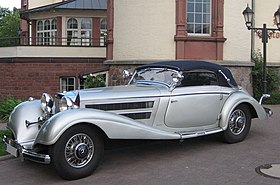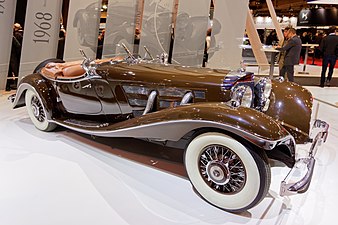Mercedes-Benz 500K
| Mercedes-Benz 500K | |
|---|---|
 Mercedes-Benz 500K Cabriolet A | |
| Overview | |
| Manufacturer | Mercedes-Benz |
| Production | 1934–1936 |
| Assembly | Sindelfingen, Germany |
| Designer | Friedrich Geiger |
| Body and chassis | |
| Body style | 2-door convertible |
| Layout | FR layout |
| Powertrain | |
| Engine | 5,018 cc (5.018 L) I8 |
| Transmission | 4-speed manual optional 5-speed manual[1] |
| Dimensions | |
| Wheelbase | 2,980 mm (117.3 in) (SWB) 3,290 mm (129.5 in) (LWB) |
| Curb weight | Up to 2,700 kg (6,000 lb) |
| Chronology | |
| Predecessor | Mercedes-Benz 380SSK |
| Successor | Mercedes-Benz 540K |
The Mercedes-Benz 500K (W29) is a grand touring car built by Mercedes-Benz between 1934 and 1936. First exhibited at the 1934 Berlin Motor Show,[1] it carried the factory designation W29.[2] Distinguished from the 500 sedan by the "K" for Kompressor (German for supercharger), only fitted to these performance cars, it succeeded the Mercedes-Benz 380 introduced just the previous year. It offered both a larger, more powerful engine and more opulent coachwork to meet customers' demands for greater luxury and performance.[3][4]
Specifications[]

The 500K used the same independent suspension as had been introduced on the 380, with a double wishbone front axle, double-joint swing axle at the rear, and separate wheel location, coil springs and damping, a world first.[1][3] Consequently, it was a more comfortable and better handling car than Mercedes' previous S/SS/SSK generation of roadsters from the 1920s, and offered greater appeal to buyers, particularly the growing number of well-heeled female drivers of the time.[1]
Pressing the throttle pedal fully engaged the Roots supercharger,[1] inducing the five litre straight-eight engine to produce up to 160 horsepower (120 kW) and making the car capable of over 160 kilometres per hour (100 mph), while consuming fuel at the rate of up to 30 l/100 km (9.4 mpg‑imp; 7.8 mpg‑US) as it did so.[1][4]
Three different chassis and eight bodies were available for customers;[1][4] the two longer "B" and "C" four-seat cabriolet versions rode on a wheelbase of 3,290 mm (129.5 in), and would later be used on other sedan and touring car models.[1] The short "A" chassis, with a 2,980 mm (117.3 in) wheelbase, underpinned the two-seater models: the Motorway Courier, and the 1936 Special Roadster which offered the highest performance.[1][5] All models featured such advanced equipment as safety glass, hydraulic brakes, and a 12-volt electrical system sufficient to bear the load of the electric windscreen wipers, door locks, and indicators.[4]
Production figures[]
Of the combined production of the 500K (342 cars), including 29 "Special Roadsters" during its two years in production, and the later 540K (419 cars) from Sindelfingen, the deliveries were:[1]
- 70 chassis without body
- 28 open cars (offener Tourenwagen)
- 23 sedans with 4 doors (mainly 500K)
- 29 sedans with 2 doors (mainly 540K)
- 12 Coupés
- 6 Autobahn cruisers (Autobahn-kurier)
- 58 Roadsters
- 116 Cabriolets A
- 296 Cabriolets B
- 122 Cabriolets C
Current value[]
Today, the cars remain highly priced for their heritage and scarcity. When the car collection of Formula One supremo Bernie Ecclestone was auctioned in October 2007, it included five pre-war Mercedes cars, and his 500K Special Cabriolet fetched almost £700,000 (US$1.45 million).[6]
Gallery[]

1934 Mercedes-Benz 500K, at Rétromobile 2017

Mercedes-Benz 500K from the rear

Mercedes-Benz 500K cockpit
References[]
Notes[]
- ^ a b c d e f g h i j "1934 - The Mercedes 500K is born". Classicdriver.com. Archived from the original on 2012-02-10.
- ^ "Herren-Rasse: Ein Automobil seiner Epoche: pompös, mächtig, respektheischend...Mercedes 500K". Auto, Motor und Sport. Heft. 20 1977: Seite 58–68. 28 September 1977.
- ^ a b "1935 Mercedes-Benz 500K Special Roadster". Sportscarmarket.com. August 2001. Archived from the original on 2008-10-28.
- ^ a b c d Frank, Michael (February 5, 2003). "Special K". Forbes.
- ^ "The 25 Most Beautiful Cars Ever". Automobile Magazine.
- ^ "Gallery: Ecclestone Merc goes for £4m". MSN. October 31, 2007. Archived from the original on April 10, 2008.
Bibliography[]
- Melin, Jan (1985). Mercedes-Benz: The Supercharged 8-Cylinder Cars of the 1930s. Vol. Volume 1. Gothenburg, Sweden: Nordbok International. ISBN 9187036002.
{{cite book}}:|volume=has extra text (help) - —————; Hernström, Sven (2003). Mercedes-Benz: The Supercharged 8-Cylinder Cars of the 1930s. Vol. Volume 2. Sparreholm, Sweden: Gamla Bilsalongen. ISBN 9163144352.
{{cite book}}:|volume=has extra text (help) - Oswald, Werner (2001). Deutsche Autos [German Cars] (in German). Vol. Band [Volume] 2: 1920–1945. Stuttgart: Motorbuch Verlag. ISBN 3613021706.
- ——————— (2018). Mercedes-Benz Personenwagen 1886-1986 [Mercedes-Benz Passenger Cars 1886-1986] (in German). Stuttgart: Motorbuch Verlag. ISBN 9783613041288.
External links[]
| Wikimedia Commons has media related to Mercedes-Benz 500 K. |
- [1] Mercedes-Benz Classic Center USA presents the 500K Cabriolet at Amelia Island Concours d'Elegance
- [2] Klassik-Oldtimer-Klatt presents the 500K Cabriolet
- Mercedes-Benz vehicles
- 1930s cars
- Rear-wheel-drive vehicles
- Cars introduced in 1934


